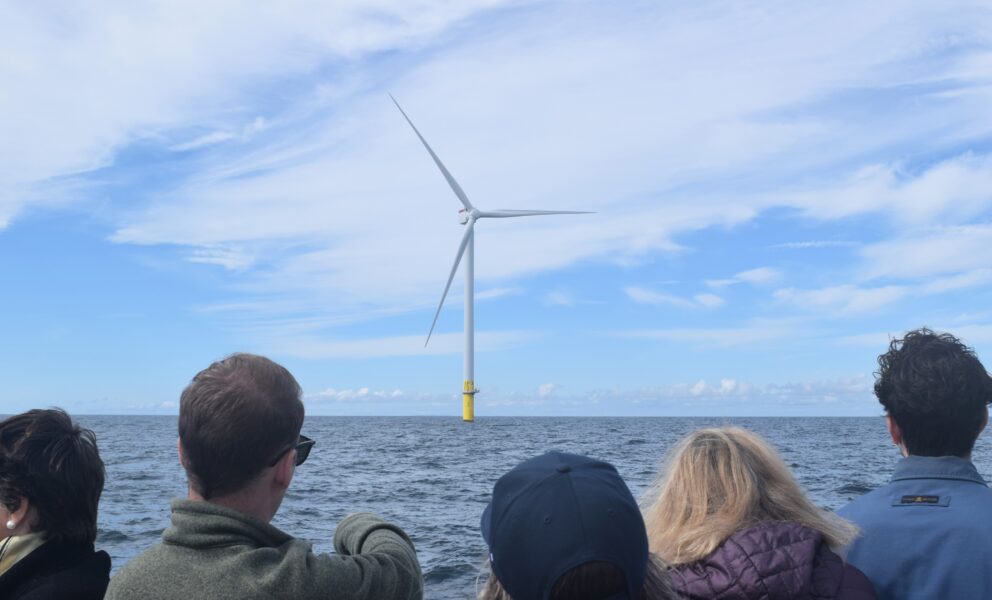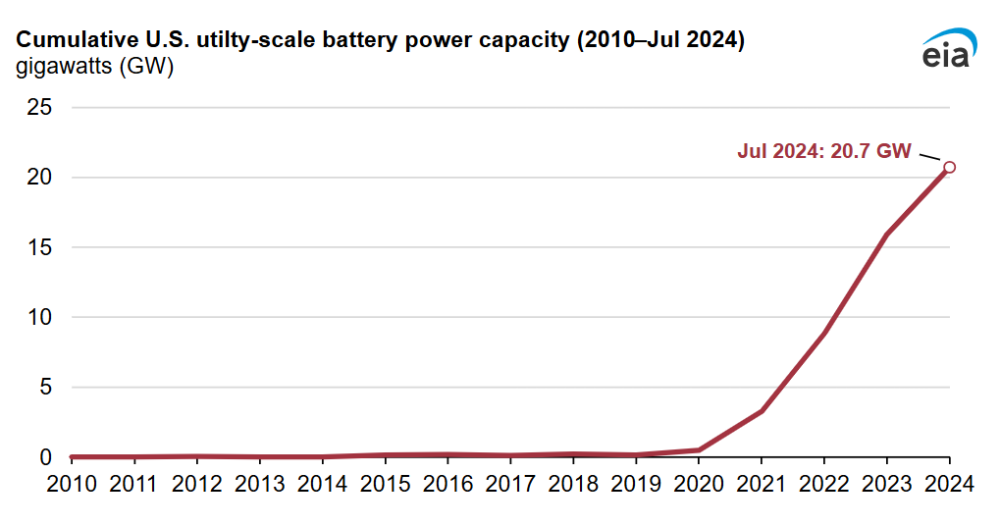2024 Year in Review: Clean Energy Progress Steeped in Solar and Storage
The Equation Read More [[{“value”:”
The end of every year is a great time for taking stock of what the year has brought—including in terms of clean energy in the power sector. As it turns out, 2024 has provided a whole lot of clean energy progress as fodder for that stock-taking. Here’s a taste, from US projects, technologies, electrons, and investment, to happenings in the world as a whole.
The United States entered 2024 with a lot of momentum, and that momentum carried us to greater heights by many metrics.
Solar
- US solar looks set to come very close to almost match, or even surpass, the record it set in 2023 for new installations. That surge was led by large-scale solar, which data/analytics firm Wood Mackenzie projects will have grown even more in 2024 than in 2023, which itself was already a huge increase over the prior year’s total. 2024’s growth was led by Texas, Florida, and California.
- Installations of commercial solar—systems on businesses, schools, and government buildings, for example—were potentially 13% higher in 2024, per Wood Mackenzie. While the amount of new solar capacity going on residential rooftops was down (substantially: potentially 26% below 2023’s total), new community solar, which is a way of reaching residential and other customers with solar produced nearby but offsite, may have been 10% higher than in 2023.
- All of the recent solar additions translate into strong increases in solar generation. The latest data from the US Energy Information Administration (EIA) suggests that solar large and small may have generated 27% more in 2024 than in 2023, and that solar might have accounted for 7% of US electricity—more than double its contribution in 2020.
Wind
- While the amount of new wind turbine capacity installed looked to be the lowest in at least six years, wind power continued to set records for generation in different regions of the country. According to the latest EIA data, wind power, the leading source of US renewable electricity, may have supplied 7% more generation in 2024 than in 2023, and accounted for almost 11% of the country’s total electricity.
- Offshore wind also made important progress, even with some strong headwinds. 2024 saw the first commercial-scale project come online, serving New York from the waters east of Long Island/south of New England. Even its modest (by current offshore wind standards) 132 megawatts of capacity quadrupled US offshore wind total.
- Two other projects under construction nearby will add a combined capacity of 1500 megawatts, and generate enough electricity for the equivalent of 800,000 households. And further south, construction was well underway on one of the country’s largest proposed offshore wind projects, off Virginia.
- Progress on the next rounds of offshore wind projects in 2024 included five more offshore wind projects receiving final federal approvals, others advancing through the federal permitting process, another offshore wind lease sale happening off the Central Atlantic coast, and the first-ever lease sale happening for the deep waters of the Gulf of Maine.

Renewable energy
- The amount of electricity supplied by US renewable energy overall (counting solar, wind, hydro, geothermal, and wood biomass) is expected to be 10% higher in 2024 than in 2023. It added up to 24% of total electricity generation in 2024, compared with 23% in 2023.
- Also in 2024, for the first time ever, solar and wind combined to generate more than coal, which was the largest source of US generation as recently as 2015.
Energy storage
- Batteries in the power sector are another shining star in the 2024 energy firmament, and have had another year of stunning growth. This EIA graph (below) shows that trajectory nicely—and, given that it’s from a few months ago, is already appreciably out of date. The 23.6 gigawatts of battery capacity as of October 2024, according to preliminary EIA data, was 23 times more than the US had installed by the beginning of 2020.
- Storage represented 20% of the new US electrical capacity installed in the first three quarters of 2024, up from 14% in 2023 (and 1% in 2019).

2024 is also notable for progress in areas that lay the groundwork for a lot more clean energy in the years to come.
Policy drivers
State leadership has been important in driving the development and adoption of clean energy for decades, and remains key to accelerating the move toward clean energy and away from fossil fuels.
- In this vein, 2024 included advances like Massachusetts’s new clean energy law, which will streamline equitable siting for clean energy projects. And like California’s strengthening of its target for reducing carbon emissions and its new program to procure substantial amounts of offshore wind, plus new geothermal energy and long-duration energy storage, to help meet that target.
- 2024 also saw many fruits of federal policy, notably the 2022 Inflation Reduction Act, including tax credits for households, businesses, and renewable energy project owners.
Transmission and grid operation
Strengthening transmission networks within and between regions of the country is key to unlocking greater amounts of renewable energy and creating a stronger, more resilient electricity grid across the country.
- 2024’s progress in this area included federal approval of an agreement between two regional electricity grid operators—the Midcontinent Independent System Operator (MISO) and the Southwest Power Pool—to add substantial additional transmission connecting them. And it included MISO’s approval of “massive investments” in transmission within its territory.
- The year also saw progress in developing an independent governance structure for energy markets in the West, which could help reduce costs, improve reliability, and speed up the transition to clean energy.
Manufacturing
Building up US capacity to make more of the tools of the clean energy revolution, including solar panels and batteries, is another key part of the transition, in part because of the jobs that come with new manufacturing.
- Substantial new manufacturing capacity in 2024 means that US factories can now crank out more than five times as much solar module capacity as before the passage of the IRA in 2022. It also means, per the Solar Energy Industries Association, that “at full capacity, U.S. solar module factories can produce enough to meet nearly all demand for solar in the United States.”
- And for the first time since 2019, the United states is now manufacturing the solar cells that are the building blocks of solar panels. Overall, solar was one of the top targets for investment in 2024 in clean technology manufacturing and deployment.
- Manufacturing capacity for key wind project components was also on the rise, Lawrence Berkeley National Laboratory reported.
The wider world offers similar signs of progress in 2024:
- Each of 2023’s top markets for solar installed at least as much solar in 2024, projected think tank Ember. Ember also projected that overall installations of solar globally during the year would be 29% higher than in 2023, which itself had a total that was way ahead of the prior year’s.
- Renewable energy generated more than half of the UK’s electricity in the third quarter of 2024, the fourth quarter in a row that it did so. And for one stunning December day, wind power alone generated more than 68% of the country’s electricity—and broke its record for total wind output just days after setting the previous record.
- Spain is expected to set its own record in 2024, with renewable energy expected to account for 56% of the country’s electricity during the year.
- The International Energy Agency (IEA) reported that global investment in renewables, electricity grids, energy storage, and energy efficiency and electrification in 2024 will have far exceeded investment in fossil fuels.
- The IEA also reported that global investment in solar power for 2024 was greater than the investment in all other electricity generation technologies combined.
The future is hard to predict, but I can say with certainty that 2025 will be different from 2024 in some ways, and similar in others. What won’t be different will be the readiness of clean energy technologies, policies, and people to continue making a difference in how we make and use electricity. And the need to keep this momentum going, in every corner of the country and beyond.
Posted in:
Energy
Tags:
batteries, clean energy, Clean Energy Momentum, clean energy transition, climate change, community solar, energy storage, Inflation Reduction Act, Manufacturing, MISO, Offshore wind, Offshore Wind Energy, Regional Transmission Organization, Renewable energy, solar energy, Solar For All, transmission, wind power
LinkedIn
John Rogers is energy campaign analytic lead at the Union of Concerned Scientists with expertise in clean energy technologies and policies and a focus on solar, wind, and natural gas. He co-managed the UCS-led Energy and Water in a Warming World Initiative, a multi-year program aimed at raising awareness of the energy-water connection, particularly in the context of climate change, and motivating and informing effective low-carbon and low-water energy solutions.
“}]]
